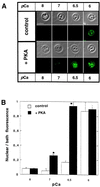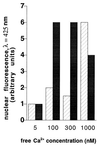cAMP-dependent protein kinase phosphorylates and activates nuclear Ca2+-ATPase
- PMID: 9689054
- PMCID: PMC21312
- DOI: 10.1073/pnas.95.16.9178
cAMP-dependent protein kinase phosphorylates and activates nuclear Ca2+-ATPase
Abstract
A Ca2+-pump ATPase, similar to that in the endoplasmic reticulum, has been located on the outer membrane of rat liver nuclei. The effect of cAMP-dependent protein kinase (PKA) on nuclear Ca2+-ATPase (NCA) was studied by using purified rat liver nuclei. Treatment of isolated nuclei with the catalytic unit of PKA resulted in the phosphorylation of a 105-kDa band that was recognized by antibodies specific for sarcoplasmic reticulum Ca2+-ATPase type 2b. Partial purification and immunoblotting confirmed that the 105-kDa protein band phosphorylated by PKA is NCA. The stoichiometry of phosphorylation was 0.76 mol of phosphate incorporated/mol of partially purified enzyme. Measurement of ATP-dependent 45Ca2+ uptake into purified nuclei showed that PKA phosphorylation enhanced the Ca2+-pumping activity of NCA. We show that PKA phosphorylation of Ca2+-ATPase enhances the transport of 10-kDa fluorescent-labeled dextrans across the nuclear envelope. The findings reported in this paper are consistent with the notion that the crosstalk between the cAMP/PKA- and Ca2+-dependent signaling pathways identified at the cytoplasmic level extends to the nucleus. Furthermore, these data support a function for crosstalk in the regulation of calcium-dependent transport across the nuclear envelope.
Figures






Similar articles
-
In vivo nuclear Ca2+-ATPase phosphorylation triggers intermediate size molecular transport to the nucleus.Biochem Biophys Res Commun. 2003 Apr 18;303(4):1225-8. doi: 10.1016/s0006-291x(03)00500-x. Biochem Biophys Res Commun. 2003. PMID: 12684066
-
Purified, reconstituted cardiac Ca2+-ATPase is regulated by phospholamban but not by direct phosphorylation with Ca2+/calmodulin-dependent protein kinase.J Biol Chem. 1996 Jun 21;271(25):14964-70. doi: 10.1074/jbc.271.25.14964. J Biol Chem. 1996. PMID: 8663079
-
Phosphorylation and activation of the Ca(2+)-pumping ATPase of cardiac sarcoplasmic reticulum by Ca2+/calmodulin-dependent protein kinase.J Biol Chem. 1993 Apr 25;268(12):8394-7. J Biol Chem. 1993. PMID: 8386159
-
Role of phospholamban in regulating cardiac sarcoplasmic reticulum calcium pump.Membr Biochem. 1984;5(2):119-30. doi: 10.3109/09687688409150274. Membr Biochem. 1984. PMID: 6143239 Review.
-
Mechanism of nuclear calcium signaling by inositol 1,4,5-trisphosphate produced in the nucleus, nuclear located protein kinase C and cyclic AMP-dependent protein kinase.Front Biosci. 2008 Jan 1;13:1206-26. doi: 10.2741/2756. Front Biosci. 2008. PMID: 17981624 Review.
Cited by
-
cAMP Signaling in Cancer: A PKA-CREB and EPAC-Centric Approach.Cells. 2022 Jun 24;11(13):2020. doi: 10.3390/cells11132020. Cells. 2022. PMID: 35805104 Free PMC article. Review.
-
The basis of nuclear phospholipase C in cell proliferation.Adv Biol Regul. 2021 Dec;82:100834. doi: 10.1016/j.jbior.2021.100834. Epub 2021 Oct 23. Adv Biol Regul. 2021. PMID: 34710785 Free PMC article. Review.
-
Protein kinase a in cancer.Cancers (Basel). 2011 Feb 28;3(1):913-26. doi: 10.3390/cancers3010913. Cancers (Basel). 2011. PMID: 24212646 Free PMC article.
-
The cAMP analogs have potent anti-proliferative effects on medullary thyroid cancer cell lines.Endocrine. 2016 Jan;51(1):101-12. doi: 10.1007/s12020-015-0597-7. Epub 2015 Apr 12. Endocrine. 2016. PMID: 25863490
-
Epac and PKA: a tale of two intracellular cAMP receptors.Acta Biochim Biophys Sin (Shanghai). 2008 Jul;40(7):651-62. doi: 10.1111/j.1745-7270.2008.00438.x. Acta Biochim Biophys Sin (Shanghai). 2008. PMID: 18604457 Free PMC article. Review.
References
MeSH terms
Substances
LinkOut - more resources
Full Text Sources
Miscellaneous

